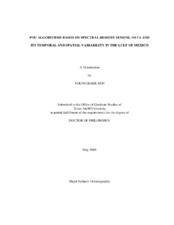| dc.description.abstract | This dissertation consists of three studies dealing with particulate organic carbon
(POC). The first study describes the temporal and spatial variability of particulate matter
(PM) and POC, and physical processes that affect the distribution of PM and POC with
synchronous remote sensing data. The purpose of the second study is to develop POC
algorithms in the Gulf of Mexico based on satellite data using numerical methods and to
compare POC estimates with spectral radiance. The purpose of the third study is to
investigate climatological variations from the temporal and spatial POC estimates based
on SeaWiFS spectral radiance and physical processes, and to determine the physical
mechanisms that affect the distribution of POC in the Gulf of Mexico.
For the first and second studies, hydrographic data from the Northeastern Gulf of
Mexico (NEGOM) study were collected on each of 9 cruises from November 1997 to
August 2000 across 11 lines. Remotely sensed data sets were obtained from NASA and
NOAA using algorithms that have been developed for interpretation of ocean color data
from various satellite sensors. For the third study, we use the time-series of POC
estimates, sea surface temperature (SST), sea surface height anomaly (SSHA), sea surface wind (SSW), and precipitation rate (PR) that might cause climatological
variability and physical processes.
The distribution of surface PM and POC concentrations were affected by one or
more factors such as river discharge, wind stress, stratification, and the Loop
Current/Eddies. To estimate POC concentration, empirical and model-based approaches
were used using regression and principal component analysis (PCA) methods. We tested
simulated data for reasonable and suitable algorithms in Case 1 and Case 2 waters.
Monthly mean values of POC concentrations calculated with PCA algorithms.
The spatial and temporal variations of POC and physical forcing data were analyzed
with the empirical orthogonal function (EOF) method. The results showed variations in
the Gulf of Mexico on both annual and inter-annual time scales. | en |


